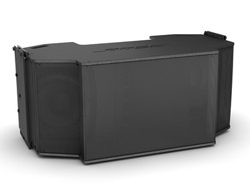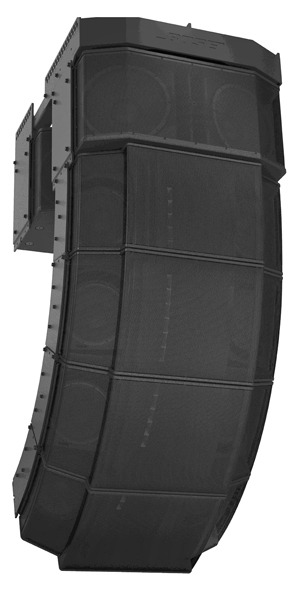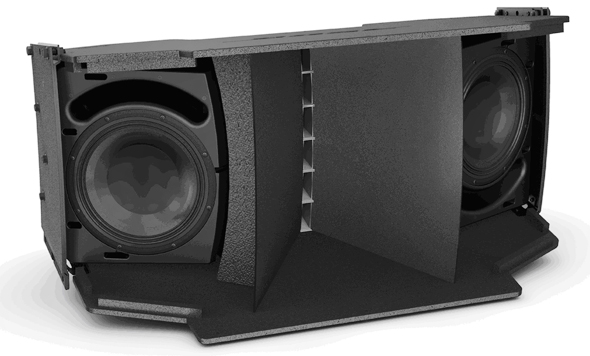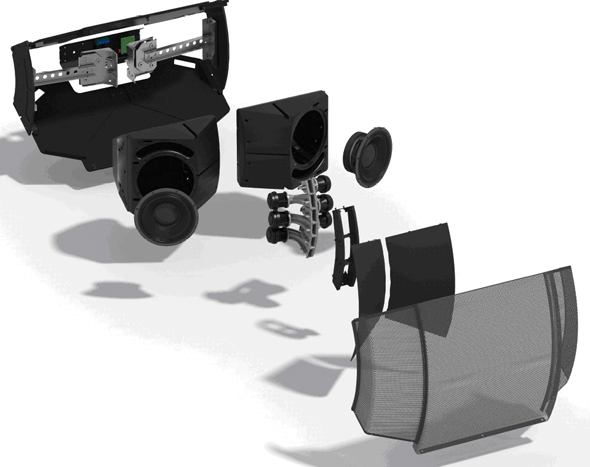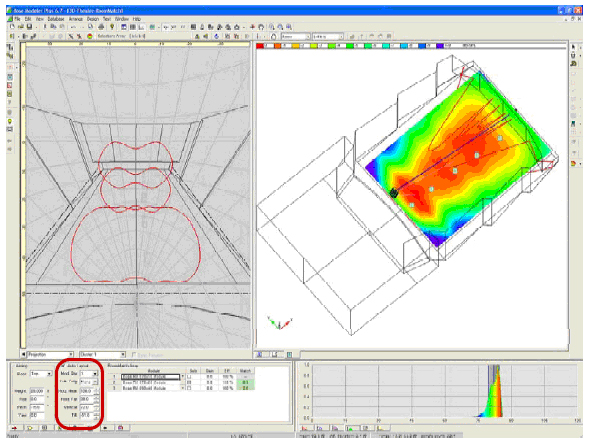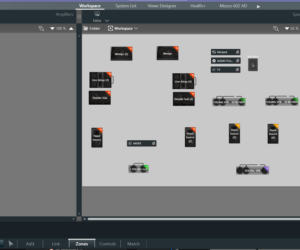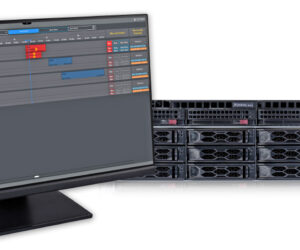Design Objectives
The Professional Systems Division of Bose Corporation has recently introduced additional coverage patterns for the RoomMatch loudspeaker series, to expand the configurations for the Progressive Directivity Array concept.
This article will review the technologies of the RoomMatch series and examine how they can be deployed to improve the overall sound quality for both live music performance and spoken word in many different room sizes, shapes, or acoustic conditions.
Product development for the RoomMatch series began more than 10 years ago by identifying the compromises of both line array and conventional point-source loudspeakers, when used in fixed-installation sound systems that require excellent sound quality for both live-music and spoken-word program material.
The design team interviewed leading system design consultants and AV integrators and reviewed more than 200 actual room-loudspeaker array designs. From this analysis, several key observations emerged that influenced the design objectives:
1) Most line array loudspeakers offer only a single, wide horizontal coverage pattern. While this approach is great for outdoor music concerts, the wide pattern can cause unwanted acoustic reflections from sidewalls in typical indoor venues. Most point-source designs offer only two or three horizontal pattern choices – an improvement, but still very limited.
2) Most sound systems for indoor venues require, on average, 50 to 80 degrees of total vertical coverage. The typical line array module limits vertical splay or coverage to about 10 degrees. Thus, most line arrays require at least 6 to 8 modules per array to achieve the required vertical coverage, which can be prohibitively expensive in smaller venues that do not require 110 dB levels.
3) While point-source loudspeaker arrays can cover large vertical angles more cost effectively, they suffer from interference “seams” when used in multiple module arrays. These seams, or destructive phase-interference patterns, result from the path length differences of multiple high-frequency drivers covering the same seating area and cause peaks and dips in the frequency response.
The design goal for RoomMatch was to solve these problems to deliver superb sound quality for both live music and spoken word, for a wide variety of room sizes, shapes, acoustics, and budgets.
Product Line Physical Description
The RoomMatch product line consists of 20 full-range modules, one companion subwoofer module, and accessory rigging hardware. The full-range modules are available with horizontal coverage pattern choices of 55, 70, 90, or 120 degrees. In the vertical plane, pattern choices are 5, 10, 20, 40, or 60 degrees, for 20 different horizontal and vertical combinations.
The model name for each full-range model describes the coverage pattern. For example, the RM7020 model provides a nominal 70-degree horizontal and 20-degree vertical coverage pattern. The recent additions to the RoomMatch series include the new RM5540, RM5560, RM9005, RM12005 and RM12010 modules.
Each 2-way, full-range module contains six (6) 2-inch titanium-diaphragm compression drivers mounted to a Continuous-Arc Diffraction-Slot (CADS) manifold. The CADS manifold provides acoustic summation, free from significant peaks or dips in response, from 500 Hz to 16 kHz, and exits into a constant-directivity waveguide with effective pattern control to approximately 1 kHz. The low-frequency section contains two (2) 10-inch cone transducers with 3-inch voice coils, with each woofer contained in a separate vented enclosure.
The full-range modules are approximately 39 inches wide and 23 inches deep. Height varies by the coverage pattern for full-range modules, with 17 inches in height for the modules with 5-degree vertical patterns, up to 27 inches for the modules with 60-degree vertical coverage. The on-axis frequency response for the full-range modules is 60 Hz to 16 kHz (+/- 3 dB) with recommended crossover and active equalization.
The line also includes a subwoofer module and rigging hardware accessories. The companion subwoofer extends usable array response down to 40 Hz and features dual Bose 15-inch high-excursion woofers. Optional side plates allow the subwoofer to be integrated with full-range modules in suspended arrays.
The rigging hardware accessories include array frames that allow up to 8 modules to be suspended with a 10:1 safety factor and include independent testing and load certification.
New Technologies
Several new Bose proprietary technologies combine to provide concert-quality sound for fixed-installations in a wide variety of room sizes, shapes, acoustic requirements, or budgets. The new transducers and waveguide technologies set a new standard in seat-to-seat consistency in frequency response and lack of interference seams in array summation.
With the modular approach, RoomMatch systems can be scaled from single modules used for modest SPL requirements to 8-module progressive directivity arrays for the highest SPL requirements, all with consistent frequency response to minimize final system EQ and tuning time.
RoomMatch Waveguide Technology
One of the breakthroughs for the RoomMatch design is the process that allows 3-dimensional constant-directivity waveguides to be manufactured from flat panels of plywood and engineered plastics.
These panels are cut by CNC machines and captured by a steel frame that also secures the woofer enclosures and side-plate rigging hardware. This patented process allows 95 percent of the parts to be common for the line of 20 different full-range modules, and can even accommodate additional patterns in the future.
This design also allows use of large-format waveguides, with effective pattern control down to about 1 kHz, without expensive tooling for each individual horn (often the limiting factor for coverage pattern choices in competitive designs). Experience has shown that large-format waveguides are essential for excellent sound quality for spoken word in many venues.
Continuous Arc Diffraction Slot Manifold
Another key technology is the new, proprietary Continuous Arc Diffraction Slot (CADS) manifold, which sums the output of six Bose EMB2 compression drivers for each full-range module.
The physical spacing of the diffraction slots is acoustically equal from module to module, which eliminates destructive phase-interference and provide seamless array summation in the audible frequency range. The included angle of the CADS manifold determines the nominal vertical coverage angle for each module as shown in the following illustration.
Bose EMB2 Compression Driver
The RoomMatch waveguide technology and CADS manifold design also required a new compression driver design. The waveguide design required a single transducer that could cover 500 Hz to 16 kHz, while the requirement of the 60-degree CADS manifold required a maximum compression driver diameter of about 3 inches.
The new Bose EMB2 compression driver, developed specifically for the RoomMatch system, pushes the design envelop for 2-inch-diaphram compression drivers. One of the keys to this performance is the new, patented phase plug design, which allows extended mid-band response from a small-diaphragm driver, while lowering total harmonic distortion by reducing the compression ratio.

Progressive Directivity Arrays
Integral to the RoomMatch system design is the ability to vary both the horizontal and vertical coverage pattern for each module in the array. Thus, narrow patterns can be selected for the far-throw positions in the array, with progressively wider patterns used for the short-throw down fill positions. This allows the radiation pattern of the array to be customized to better match the coverage area defined by the room dimensions.
Additionally, this approach uses the differences in module directivity index (DI) to help equalize the levels of far-throw and near-throw modules without drastic amplifier attenuation, which improves overall system efficiency. Bose has termed this new class of curvilinear array the Progressive Directivity Array.
Modeler Array Design Tool
To help system designers select the correct modules for optimal array performance for the target room coverage and level requirements, a new “Array Design Tool” has been added to the Bose Modeler sound system design software.
The user inputs the room dimensions and selects the desired number of modules (often based on budget requirements), and then the array tool automatically calculates the recommended array modules and maps the predicted coverage, sound level, and intelligibility of selected locations on the room model.
PowerMatch Amplifier With Loudspeaker DSP
The Bose PowerMatch PM8500 configurable professional power amplifier is designed to provide optimal amplification and loudspeaker DSP for all configurations of RoomMatch arrays.
The PM8500 is a class-D amplifier with a unique dual-feedback loop topology that delivers 4,000 watts rated power with class-leading audio quality, efficiency, and reliability, in a 2-rack unit chassis weighing 28 pounds. The outputs may be configured to provide 8 x 500, 4 x 1,000, 2 x 2,000 watts, or mixed combinations. With recommended configurations, one PM8500 amplifier can power four RoomMatch full-range modules or two subwoofer modules.
The onboard DSP provides loudspeaker processing with presets for all Bose Professional loudspeakers. Front-panel controls allow selection of configurations and loudspeaker presets. Additional settings are accessed via the USB interface and ControlSpace Designer software, with a separate PM8500N model that includes integrated Ethernet control and monitoring functions.
The PM8500 amplifier is available separately and can be used with almost any professional loudspeaker.
Real-World Advantages
RoomMatch and PowerMatch systems have already generated positive reviews from leading consultants and integrators. Significant installations for RoomMatch include the Oakland LDS Temple in California, the Evergreen Christian Community in Washington, the Telus Spark Science Centre in Calgary, the Nippon Budokan in Japan, Kinnarps Arena in Sweden, the Alexandre Dumas Theatre in France, and the SM Mall of Asia Arena in the Philippines.
Using RoomMatch modules in progressive directivity arrays, design consultants and integrators can realize systems with unprecedented sound-quality consistency from seat to seat, even in acoustically challenging rooms.
The large-format waveguides contribute to outstanding intelligibility for spoken word, while all technologies combine to provide the tonal balance and dynamic range required for concert-quality live music production. In fact, several consultants have commented that they were surprised with how little time is required for final room EQ with the RoomMatch and PowerMatch system, while providing outstanding sound quality for both spoken word and live music production.
Another advantage of the RoomMatch modular design is that it allows SPL to be scaled for differing budgets independent of vertical coverage. With conventional line arrays, the vertical coverage is narrowly confined by the number of boxes in the array.
Thus, venues that require large vertical angles for coverage (typical for main floor plus balcony seating), always require a large number of conventional line array boxes, which drives system costs beyond many budgets. With RoomMatch modules, designers can realize the required vertical angle, for example 80 degrees, by using arrays configured from two to eight modules, depending on SPL, coverage control, and budget requirements.
In summary, RoomMatch systems can provide concert-quality sound for live music production, with high intelligibility for spoken word, in fixed-installation sound systems for a wide variety of room sizes, shapes, acoustic requirements, or budgets.
In addition, leading design consultants and integrators have reported that RoomMatch progressive directivity arrays provide very consistent sound quality from seat to seat, with virtually no audible array interference seams.
More information regarding RoomMatch is provided here.
Alan B. Shirley is product line manager and Paul Fidlin is director of engineering for Bose Professional Systems Division.
Related Links on PSW:
Bose RoomMatch Facilitates Versatile System At New Iowa High School Gymnasium
Bose PowerMatch 8500/8500N Power Amplifiers Drive New System At The Villages
Bose RoomMatch Arrays Deliver Intelligibility, Music Quality At Oakland LDS Temple
Bose Offers New Accessories For ControlSpace Processor & PowerMatch Systems
Bose Expands RoomMatch Array Module Loudspeakers With Five New Coverage Patterns


